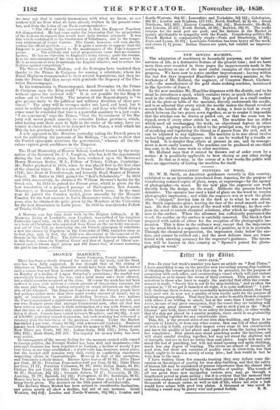NEW SEWING MACHETE.
The adaptation of machinery to household purposes, and the minor services of life, is a distinctive feature of the present time ; and we have more than once recorded in these pages the improvements made in the sewing machine as one of the most useful examples of this mechanical progress. We have now to notice another improvement ; having within the last few days inspected Haseltine's patent sewing machine in the workshops of Mr. Holland, the engineer, of Compton Street, Clerken- well,—the manufacturer of the gold chain making machine, mentioned in the Spectator of June 4.
In the new machine Mr. Haseltine dispenses with theAuttle, and in ifs stead he introduces a spool, which contains twice as much thread as that used in the ordinary machines. This spool is placed in a small sunken bed in the plate or table of the machine, directly underneath the needle, and is so adjusted that every stitch the needle makes the thread revolves around the outside of the spool. By so doing, a knot is tied in every stitch between the two pieces sewn together, so as to render it impossible that the stitches can be drawn or pulled out, or that the seam can be ripped, even if every other stitch be out. The machine has no slides which need oil overhanging the work, an objectional feature in other machines. A spring action is fitted to the principal arm, for the purpose of steadying and regulating the thread as it passes from the reel, and it can be adjusted to any tightness. The machine is in size about twelve inches long and six inches square, and it can be worked by a treadle or by hand. It is simpler than others at present in use, and its manage- ment is more easily learned. The machine can be produced at one-third less cost, to do the same work as other machines.
Mr. Holland says that it cannot be thrown out of order even by a novice : it is peculiarly applicable to boot closing or any other strong work. Be that as it may, in the course of a few weeks the public will have an opportunity of testing the machine for itself.


























 Previous page
Previous page